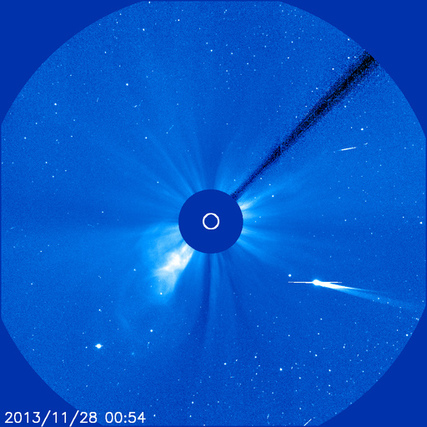
So we can say that ISON is performing well at the time when the picture was taken. And may be the nucleolus is not fragmented till now.
 Latest image of ISON. Taken at 06:24AM (IST). It shows distinct dust tail as well as Ion tail. The comet has gone much brighter. Scientists are keeping fingers crossed. We are waiting for their opinions and observation interpretations. So we can say that ISON is performing well at the time when the picture was taken. And may be the nucleolus is not fragmented till now.
1 Comment
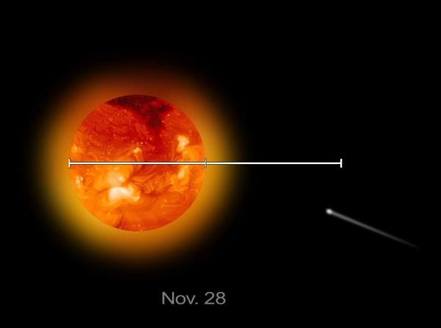 NO. It is not. This idea is grossly wrong one. It has developed among a large section of people- may be due to some misunderstanding- or may be due to some unintentional but improper presentation of facts by a section of media. ISON will come at its closest distance to Sun on 28th Nov. Thus, instead of becoming visible, it will remain hidden behind strong aura of Sunlight. The comet is expected to become visible again after 5th or 6th December- well… if it survives the extreme level of heat and Solar wind pressure at that close distance from Sun. As a matter of fact, it has already become invisible. It is also disintegrating minimizing its chance of re-appearance in our sky with a bright and glorious glare. WARNING: Comet ISON is extremely close to the Sun and you should NOT attempt to observe it in binoculars or telescope unless you are highly experienced in making these observations. LOOKING TO SUN WITHOUT PROPER SAFETY MEASURES TAKEN OF EXPERT GUIDANCE MAY BE DANGEROUS. IT MAY CAUSE IRREVERSIBLE DAMAGE TO EYE AND/OR OPTICAL EQUIPMENT. 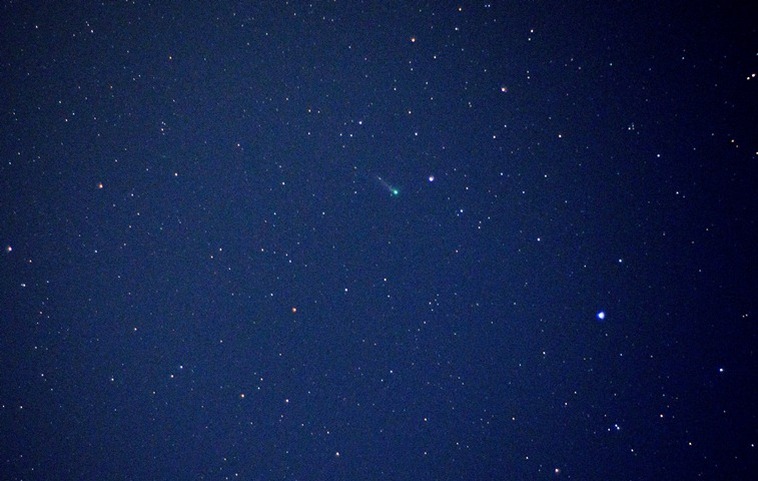 Picture taken by : Kartik Kiran Wat Location : Amravati City Outskirts , Maharashtra , India ( 20.9258° N, 77.7647° E ) Date & Time : 23rd November, 2013 , 5:35:00 IST Details of instrument used in observation : Used Nikkor 50mm Lens , f/1.8 . 10 sec exposure shots and then processed with photo editing software. Congratulation to Kartik for this Image.. you may also submit your images to our website. Send them to [email protected] 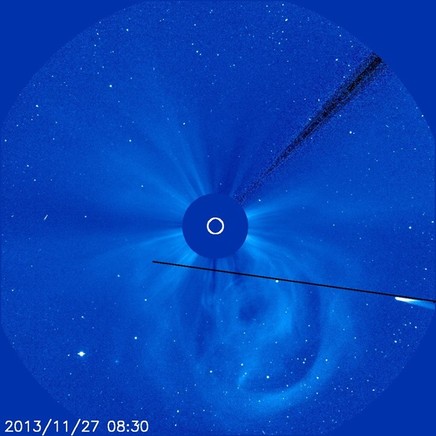 It has become too dynamic. Changing every hour. New info- new image- new knowledge base are coming every moment. Attached image is taken with a space born telescope. See what Jakub Cerny of CIOC (A global conglomeration of experts to study ISON) says on this: The long thin tail visible originaly on STEREO-A images is now also visible in SOHo C3 images. From SOHo images it is clearly visible that this is not the ion-tail and it is more likely synchronic feature. Synchronic features are originated in very shortime extensive emission of various sized dust grains. Such feature was observed after disruption of comet Lovejoy. So it really seems something disintegrated in here if it was fragment or entire nucleus is part of questions. Actually the nucleus disruption seems to be still the best option. 1. As my calculations yesterday pointed if there would be anything active in coma it would correspond to one spherical nucleus with diameter 630 - 100 meters. If there will be more subfragments (as seen in C/1999 S4 (LINEAR) case) such active surface can be easily reach by larger number of 20-50 meter sized fragments. 2. Comet brighten nearly as simple reflecting body, actualy if some post-disruption larger subfragments keep to disintegrating, amount of dust in coma will grow and brightnes can slightly grows. 3. Ion tail is still not present, there is small or no outgassing in coma. 4. Spine tail a synchronic feature observed in case of disintegrated comets is present, and even it looks that brightness is enhanced towards this tail, which indicate that majority of dust comming from this event. We had a Comet LOVEJOY shooting session in the night between 23rd and 24th Nov. This is one of the frames captured. Location: Bidhannagar. North Dinajpore: West Bengal. India.
Camera: Nikon D7000. Lens: Tamron 300mm. f/5.6. S: 30sec x 4. Sky transparency at location was bad due to fog and strong Moon light. ISON NEWS FLASH: 07:00 UT. 26th Nov. As the latest Jet Propulsion Laboratory info says- ISON is not leaving us forever. It will come back again. After 581480.34 years. Now its orbit is being considered as a long long ellipse with its eccentricity as .9999982136165803.But yes, scientists are still not sure on this. calculations are going on.
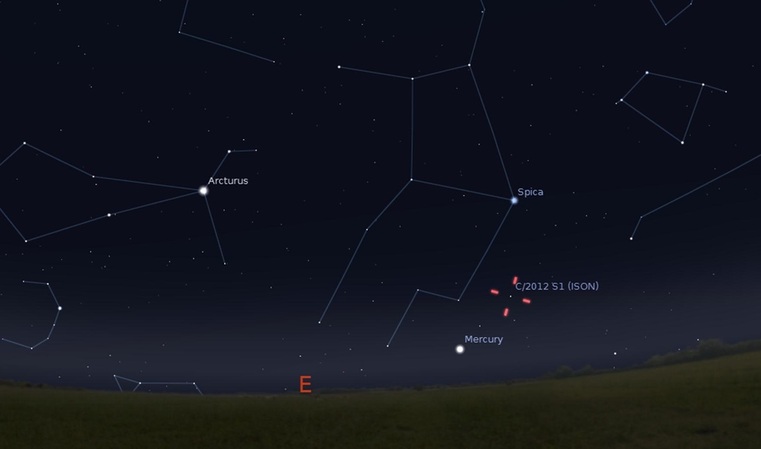 It is almost time to say Good Bye to Comet ISON in its first phase of visibility. Every day the comet is coming closer to Sun and getting deeper and deeper into the glare of Sun making it a difficult object to see. Moreover, though at weaning phase, Moon is still too bright in early morning. However, here is the position of that for 21st Morning just about 1.5 hour - 1hour before sun rise . If anyone gets interested to take a desperate attempt to find it. This simulated image is for lat 26, Long 88. But the angular distance of the comet from bright star Spica will remain almost same for almost all coordinates. All the best and wishing you a clear sky. Happy to present you the pictorial record of SWAN's first glimpse of Comet ISON. Taken on 17th Nov 04:59AM IST. Had a plan to shoot it from Jalpaiguri through guided mount and Telescope. But, sudden cloud formation in east horizon from 3:00AM forced us to take hasty decision to leave all equipment and move only with camera and lens. A risky journey of 30km, a chase for clear sky, it was. But finally came out to be rewarding. May not be of very high class, but we loved this image, our first view of Comet ISON.
This is a non stacked single frame image of comet ISON. 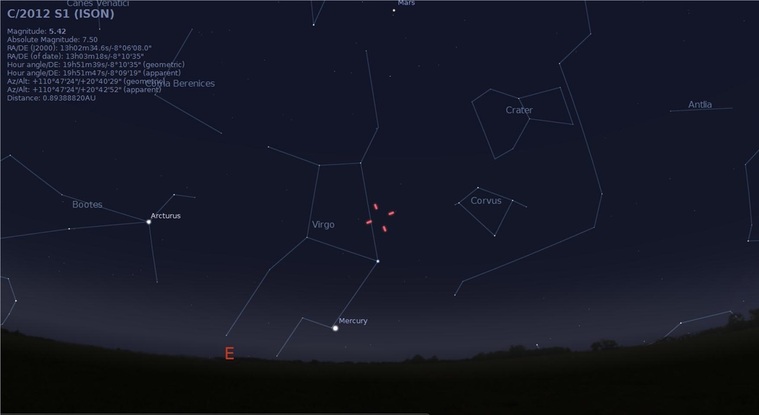 Position of ISON will be around 15-25 degree above Eastern Horizon between 4.30 am to 5.15 am this (16th Nov IST) morning (All over India). Please observe it from your location and then report us at http://www.skywatchersindia.com/brightness--visibility.html with details. You may observe ISON only with naked eye or any optical gadget. Submit the details of your gadget too, if any.
Finally it has come into the domain of naked eye. Comet ISON. The much awaited Comet is now visible with naked eye after a massive outburst of its materials due to Solar heat and gravitational pull. In good side, the outburst has increased the comets visibility, in bad side it has increased the chance of the comet’s disintegration. Thirteen days more for the comet to reach the closest distance to Sun. Not known whether it can survive that long or not. Thus, have a look now, get a glimpse of the great comet, experience the view of a celestial guest in our sky from the outermost layer of our solar System. Like many from different corners of the globe you too can contribute your observation report to our site.
Visit : http://www.skywatchersindia.com/brightness--visibility.html |